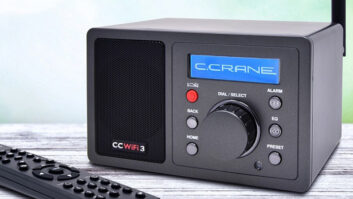Where have all the Internet radios gone?
An “Internet radio receiver” captures streaming audio from the Web, then plays it through some kind of radio-type device. Before the dot-com crash, they were the next big thing on the horizon.
After all, thousands of commercial and Internet-only stations were on the Web and more were signing on every day. With this music selection online, why would anyone endure over-the-air top 40 radio?
Then vs. now
That was then, and this is now. The survivors of the dot-com blowout are a little wiser (we hope), a little (or a lot) poorer and leery of anything with an “e-” or “i-” prefix attached to it.
Among the demised is the Kerbango Internet Radio. Styled to look like a modernized AM/FM radio receiver, the Kerbango was able to receive these bands plus plug into the Web to access RealAudio stations and MP3s. It came close to making it to market, with demo versions winning awards from the 2001 Consumer Electronics Show and Popular Mechanics magazine.
Kerbango fell victim to the financial ills of 3Com, however, which bought the Internet radio startup for $80 million in 2000.
A few months later the dot-com bomb blew up, and 3Com found itself in a brutal fight for survival. As a result, the company axed “non-core businesses,” including Kerbango.
Today, www.kerbango.com no longer hosts pictures of the cheery blue Kerbango prototype. Instead, the site presents a 3Com logo, a lone tree in a golden field topped by a blue sky and the words “End of Life.”
The other Great Hope of Internet Radio was the Sonicbox from iM Networks.
Fortunately, this technology survived the dot-com crash. Now billed as the iRhythm Remote Tuner, the technology is included in consumer equipment made by Philips and Creative Technology.
Best feeds
An iM Networks’ Internet radio does not scan the entire Web for audio streams. Instead, the company collects the best feeds, categorizes them by genre and makes them available free of charge at its Web site, www.imnetworks.com.
Once connected to the Web, the iM Networks receiver contacts the site, and a list of genres/stations is displayed on the receiver’s LCD screen – this is the so-called “iM Band” – and selections are made using controls onboard the receiver.
Philips first incorporated iM Band tuning in its FW-i1000 mini-stereo, which was billed as offering “world-wide Internet Radio!” Next, iM Tuning was added to the Streamium MC-i200 mini-stereo with the slogan “Don’t Dream It. Stream It.”
In both cases, the iM Band is just one of many features included in the mini-stereos, along with the ability to download and play MP3s from a personal computer, CD/CR-R/CR-RW playback and, of course, AM/FM radio reception.
iM Radio Internet Tuner software also can be found in SoundBlaster Audigy computer soundcards from Creative Technology.
Creative has built an external SoundBlaster device known as the Extigy. Resembling a conventional AM/FM tuner, the Extigy bridges the gap from a PC to headphones and/or speakers. It also can support CD, DVD and MP3 players, making the Extigy the 21st century heart of a conventional home entertainment system.
Finally, Panasonic has licensed iM Radio tuning for its planned Broadband Set Top Box, and the Acer iRhythm Remote Tuner – the renamed Sonicbox – remains available through www.imnetworks.com.
Other options
A few other options for an Internet radio receiver are on the market or will be soon.
The Simple Devices SimpleStereo unit essentially is a wireless bridge between a PC and home stereo unit, but its ability to transmit streaming audio from the Web makes it a de facto Internet radio. This unit is being sold as the Motorola SimpleFi.
British Telecom is pumping up demand for its broadband services by releasing a portable broadband radio. This walk-around device will let BT broadband subscribers access Internet radio stations anywhere in the house. Details are sketchy at press time; however, it appears that this radio will work as an extension of BT’s home wireless networking product, which is also being sold along with broadband.
Penguin Radio continues to say that it will be producing a Linux-based Internet radio someday.
“We’d love to have released this to you about a year ago, but our goal has always been to build the best quality device that is functionally a computer, but works like a radio,” the company’s Web site stated. “Adding this level of functionality to a small device is tricky.” Apparently so.
And although Bose continues to support its Wave/PC Interactive Audio System – a version of the Bose Wave radio that also connects to the Web – the Wave/PC was discontinued by the company last year.
So the Kerbango and Wave/PC are long gone, but the nascent market for Internet radio receivers did not die with them.
Granted, this method of tuning webcasters has not developed nearly as fast as many expected. However, thanks to the ongoing efforts of iM Networks and others, it has at least arrived in the consumer marketplace.







